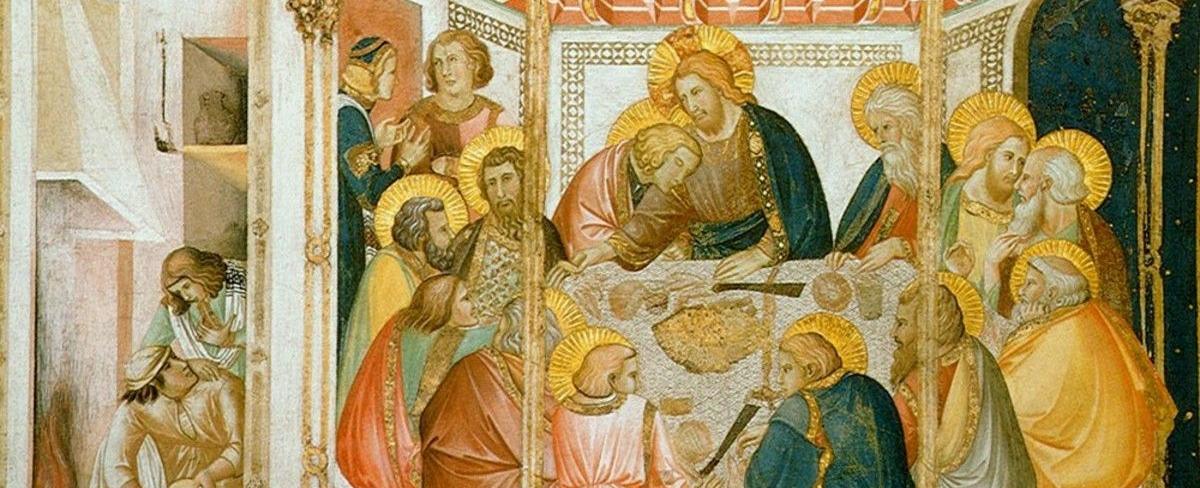Holy Thursday and the Franciscan Tradition

This blog continues our Lent 2021 series of reflections on the Franciscan Intellectual-Spiritual Tradition by a variety of women and men Franciscans.
Holy Thursday begins the Paschal Triduum, also known as the Easter Triduum. During these special days we recall Christ’s suffering, dying, and rising—the events that reveal the full depths of God’s love for our broken humanity.
Following Jesus’ footprints
This is the Good News that Saint Francis above all wanted to share with others. He wrote in the Letter to the Faithful:
“As His Passion was near, Jesus celebrated the Passover with His disciples and, taking bread, gave thanks, blessed and broke it, saying: Take and eat: This is My Body. And taking the cup He said: This is My Blood of the New Covenant which will be poured out for you and for many for the forgiveness of sins. Then He prayed to His Father, saying: Father, if it can be done, let this cup pass from me. And His sweat became as drops of blood falling on the ground. Nevertheless, He placed His will in the will of His Father, saying: Father, let Your will be done; not as I will, but as You will. His Father’s will was such that His blessed and glorious Son, Whom He gave to us and Who was born for us, should offer Himself through His own blood as a sacrifice and oblation on the altar of the cross: not for Himself through Whom all things were made, but for our sins, leaving us an example that we might follow His footprints.”
An earthy, truly human event
In the magnificent fresco in the Lower Basilica of San Francesco in Assisi (c. 1319) (the main image with this blog), the artist Pietro Lorenzetti has placed mundane details into the scene to emphasize that this “last supper” was not a sacred ritual event with the disciples grouped passively around the table; instead, the disciples are chatting with one another in a number of conversations, with kitchen workers off to the side and animals eating the scraps—all accentuating that this supper was a very earthy, truly human event in the midst of our life.
Institution of the Eucharist
Two facets of Christ’s giving himself to others that we celebrate today were especially compelling to Francis and Clare. The first was the institution of the Eucharist that continues to activate that self-giving among us now. Francis says in Admonitions 1:16-19:
“Behold, each day He humbles Himself as when He came from the royal throne into the Virgin’s womb; each day He Himself comes to us, appearing humbly; each day He comes down from the bosom of the Father upon the altar in the hands of a priest. As He revealed Himself to the holy apostles in true flesh, so He reveals Himself to us now in sacred bread.”
Washing of the feet
The second was the washing of the feet that expressed the life of humble service to which Francis and Clare committed themselves. And so, Lorenzetti painted a companion fresco to the meal depicting this event. Jesus had said to the disciples: “Do you realize what I have done for you?. . . I have given you a model to follow, so that as I have done for you, you should also do” (John 13:12,15).
A central metaphor for Francis’s followers
For Clare and Francis, then, foot-washing became a central metaphor for the daily lives of Poor Sisters and Lesser Brothers. Francis urged his brothers: “Let no one be called ‘prior,’ but let everyone in general be called a lesser brother. Let one wash the feet of the other” (Earlier Rule, 6.3). And Clare as abbess of the community of San Damiano wanted to be seen above all as one who humbly served her sisters:
“Rarely would she give an order, instead she would do things spontaneously, preferring rather to do things herself than to order her sisters. She herself washed the commodes of the sick; . . . She frequently and reverently washed the feet of the serving [sisters] who returned from outside and, after washing them, kissed them” (The Legend of Saint Clare 12:7-9).
An intimate relationship between two dimensions
As Saint Bonaventure explained, there is theologically an intimate relationship between these two dimensions: by eating Christ’s body and blood, we are transformed into his Body and so live by his power, like Jesus giving our life to others in service:
Dominic Monti, OFM
Professor of Franciscan Research in the Franciscan Institute of St. Bonaventure University
Dominic V. Monti, OFM, is a Franciscan Friar of Holy Name Province (USA) and currently professor of Franciscan Research in the Franciscan Institute of St. Bonaventure University. He devoted the greater part of his ministry to teaching the History of Christianity, in particular the history of the Franciscan movement. He has contributed two volumes to the Works of St. Bonaventure series and is author of Francis & His Brothers, a popular history of the Friars Minor.

